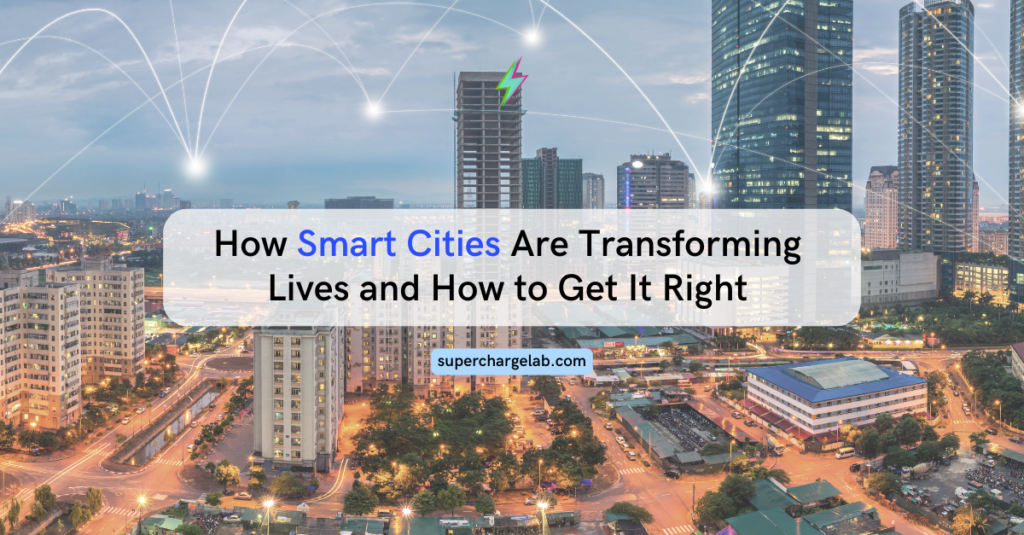
“Smart cities” isn’t just a fancy term – it’s a dream for the future where technology fits perfectly into our city lives, making life better, greener, and more fun. But do smart cities actually work? Let’s look at the good stuff they can bring, the problems they might cause, and how we can make sure these smart cities are good for people, too.
- The Promise of Smart Cities
The idea of a smart city is really exciting. The city where traffic lights change depending on how much traffic there is, so you don’t get stuck in unnecessary traffic on any given day, wasting resources. Think about sensors in your neighborhood that check the air to make sure it’s clean and systems that let people know if there’s too much pollution. Or picture streetlights that get dimmer when no one’s around, saving energy.
But smart cities aren’t just about making things easier. They can also help with big problems like climate change, not having enough potable water, and making sure everyone has a fair chance at thriving. For example, smart power grids can make sure we use energy wisely and rely less on things that pollute the air. Smart water systems can stop leaks and make sure we don’t run out of water. And with public infrastructure like bike sharing and electric buses, we can have cleaner air and easier ways to get around.
- Real-World Examples: Smart Cities in Action
The concept of smart cities might sound futuristic, but several cities around the globe are already demonstrating how these technologies can create real and tangible benefits for residents. Let’s take a look at a few examples:
- Barcelona, Spain: This vibrant city has implemented a smart traffic management system that leverages sensors and data analytics to optimize traffic flow in real time. By adjusting signal timings based on current conditions, the system has reduced travel time by an impressive 21% and cut emissions by 15%.
- Singapore: Singapore’s ambitious Smart Nation initiative aims to harness technology to improve the lives of its citizens. This comprehensive program encompasses a wide range of smart city solutions, including intelligent traffic lights, self-driving buses, and a nationwide network of sensors that monitor everything from air quality to crowd density, enabling data-driven decision-making to address urban challenges.
- Songdo, South Korea: This meticulously planned city was designed from the ground up with smart technology in mind. Songdo boasts a state-of-the-art pneumatic waste disposal system that eliminates the need for noisy and polluting garbage trucks. A smart grid optimizes energy use in buildings and public spaces, and a ubiquitous sensor network provides real-time data on everything from traffic patterns to water consumption, helping city officials make informed decisions about resource management.
- The Challenges of Smart Cities:
While the potential of smart cities holds great promise, there are also significant challenges that must be addressed to ensure that these technological advancements truly benefit everyone.
- Data Privacy and Security: Smart cities rely on vast amounts of data collected from sensors, cameras, and other devices. Protecting this data from unauthorized access and misuse is paramount. Robust cybersecurity measures, transparent data governance policies, and clear regulations are essential to safeguarding the privacy and security of citizens’ information.
- The Digital Divide: Not everyone has equal access to technology or the skills to use it effectively. This digital divide could be exacerbated in smart cities if not addressed proactively. To ensure that all residents can benefit from smart city initiatives, it’s crucial to invest in digital literacy programs, provide affordable internet access, and design user-friendly interfaces for smart city applications.
- Balancing Technology and Human Connection: While technology can enhance our lives in many ways, it’s important to remember the value of human connection and community. Overreliance on technology could lead to social isolation and a decline in face-to-face interactions. Smart cities must strike a balance between technological innovation and human-centered design, creating spaces that encourage social interaction, community building, and a sense of belonging.
- Smart Cities for People
Building successful smart cities requires a people-centric approach. More than just deploying the latest technology; it’s also using technology to create cities that are more livable, equitable, and sustainable for all residents. This involves:
- Inclusivity: Smart city solutions should be designed with inclusivity in mind, ensuring that they benefit all residents, regardless of age, income, or technical ability. This means prioritizing accessibility, affordability, and ease of use.
- Community Engagement: Engaging residents in the planning and decision-making process is crucial for the success of smart city initiatives. Public consultations, online forums, and citizen-led projects can ensure that smart city solutions address the needs and priorities of the community.
- Resilience: Smart cities should be built to withstand a variety of challenges, from natural disasters to cyberattacks. This means investing in redundant systems, backup power sources, and robust cybersecurity measures to ensure that essential services can continue to operate even in the face of adversity.
- The Future We Build Together:
The future of our cities, we all have a hand in shaping it. When people who make the rules, city planners, technology experts, and everyday folks work together, we can create smart cities that use technology to make our lives better. But it’s important to remember that these cities should still feel like home, keeping the things that make them special. We want technology to help and empower us, not control or limit us.
In conclusion, smart cities have the potential to revolutionize urban living, but their success hinges on a people-centric approach that prioritizes inclusivity, community engagement, and resilience. We can create smart cities that are technologically advanced, livable, and sustainable for generations to come. If you have ideas for making your city smarter, let’s talk! We’re excited to explore the possibilities with you. https://calendly.com/superchargelab